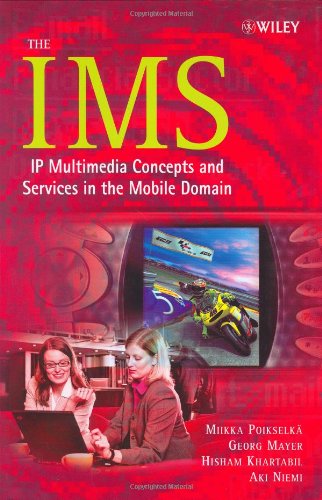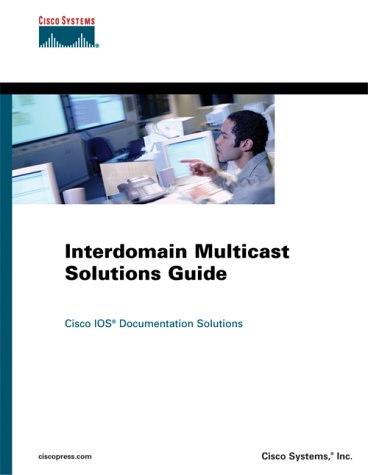Miikka Poikselka, Georg Mayer, Hisham Khartabil, Aki Niemi9780470871133, 047087113X
Table of contents :
Team DDU……Page 1
Contents……Page 8
Foreword……Page 20
Preface……Page 22
Acknowledgements……Page 24
List of Figures……Page 26
List of Tables……Page 30
PART I: ARCHITECTURE……Page 32
1.1 Why the Internet Protocol Multimedia Subsystem was developed……Page 34
1.2.2 3GPP Release 99 (3GPP R99)……Page 36
1.2.4 3GPP Release 5 and Release 6……Page 37
1.3.1 Internet Engineering Task Force……Page 39
1.3.3 Third Generation Partnership Project 2……Page 40
2.1.1 IP connectivity……Page 42
2.1.2 Access independence……Page 43
2.1.4 IP policy control for ensuring correct usage of media resources……Page 44
2.1.6 Charging arrangements……Page 45
2.1.7 Support of roaming……Page 46
2.1.9 Service control model……Page 47
2.1.11 Layered design……Page 48
2.2 Description of IMS-related entities and functionalities……Page 49
2.2.1 Proxy-CSCF……Page 50
2.2.2 Policy Decision Function……Page 51
2.2.3 Interrogating-CSCF……Page 52
2.2.4 Serving-CSCF……Page 53
2.2.5 Home Subscriber Server……Page 54
2.2.8 Multimedia Resource Function Processor……Page 55
2.2.9 Application server……Page 56
2.2.10 Breakout Gateway Control Function……Page 57
2.2.14 Security gateway……Page 58
2.2.16 GPRS Service entities……Page 59
2.3 IMS reference points……Page 60
2.3.1 Gm reference point……Page 61
2.3.2 Mw reference point……Page 62
2.3.4 Cx reference point……Page 63
2.3.5 Dx reference point……Page 69
2.3.6 Sh reference point……Page 70
2.3.8 Dh reference point……Page 73
2.3.12 Mj reference point……Page 74
2.3.16 Mp reference point……Page 75
2.3.18 Gq reference point……Page 76
3.2 Registration……Page 80
3.3 Session initiation……Page 82
3.4.1 Identification of users……Page 84
3.4.3 Identification of network entities……Page 89
3.5.1 IP Multimedia Services Identity Module……Page 90
3.6 Security services in the IMS……Page 91
3.6.1 IMS Security Model……Page 92
3.6.3 Network domain security……Page 93
3.6.4 IMS access security for SIP-based services……Page 97
3.6.5 IMS access security for HTTP-based services……Page 101
3.7 Discovering the IMS entry point……Page 103
3.8.1 S-CSCF assignment during registration……Page 104
3.9 Mechanism for controlling bearer traffic……Page 106
3.9.1 SBLP functions……Page 108
3.10.1 Charging architecture……Page 122
3.10.2 Charging information correlation……Page 130
3.11.1 Service profile……Page 132
3.12.2 Creation of the filter criteria……Page 136
3.12.3 Selection of AS……Page 138
3.12.4 AS behaviour……Page 139
3.13.1 IMS-originated session toward a user in the CS core network……Page 140
3.14 Mechanism to register multiple user identities at once……Page 142
3.15 Sharing a single user identity between multiple terminals……Page 144
3.16 SIP compression……Page 145
PART II: DETAILED PROCEDURES……Page 148
4.1 The example scenario……Page 150
4.2 Base standards……Page 152
5.1 Overview……Page 154
5.2 Signalling PDP context establishment……Page 156
5.5.1 Overview……Page 157
5.5.2 Constructing the REGISTER request……Page 160
5.5.4 From the P-CSCF to the I-CSCF……Page 162
5.5.6 Registration at the S-CSCF……Page 163
5.5.7 The 200 (OK) response……Page 164
5.5.8 The Service-Route header……Page 165
5.5.10 Third-party registration to application servers……Page 166
5.6.1 Overview……Page 168
5.6.2 HTTP digest and 3GPP AKA……Page 170
5.6.3 Authentication information in the initial REGISTER request……Page 171
5.6.4 S-CSCF challenges the UE……Page 172
5.6.6 Integrity protection and successful authentication……Page 173
5.7.1 Overview……Page 174
5.7.2 Establishing an SA during initial registration……Page 175
5.7.3 Handling of multiple sets of SAs in case of re-authentication……Page 177
5.7.4 SA lifetime……Page 180
5.7.5 Port setting and routing……Page 181
5.8.2 Overview……Page 186
5.8.3 SIP Security Mechanism Agreement-related headers in the initial REGISTER request……Page 188
5.8.4 The Security-Server header in the 401 (Unauthorized) response……Page 189
5.8.6 SIP Security Mechanism Agreement and re-registration……Page 190
5.8.7 Related standards……Page 192
5.9.1 Overview……Page 193
5.9.2 Indicating willingness to use SigComp……Page 194
5.9.3 comp=SigComp parameter during registration……Page 195
5.10.1 P-Access-Network-Info……Page 196
5.10.3 Related standards……Page 197
5.12.1 Overview……Page 198
5.12.2 Public and private user identities for registration……Page 199
5.12.3 Identity derivation without ISIM……Page 200
5.12.4 Default public user identity/P-Associated-URI header……Page 201
5.12.5 UE’s subscription to registration-state information……Page 202
5.12.6 P-CSCF’s subscription to registration-state information……Page 204
5.12.8 Registration-state information in the body of the NOTIFY request……Page 206
5.12.9 Example registration-state information……Page 208
5.12.10 Multiple terminals and registration-state information……Page 210
5.12.11 Related standards……Page 211
5.13.2 Network-initiated re-authentication……Page 212
5.13.3 Network-initiated re-authentication notification……Page 213
5.13.4 Related standards……Page 214
5.14.1 Overview……Page 215
5.14.2 User-initiated de-registration……Page 216
5.14.4 Related standards……Page 219
6.1 Overview……Page 222
6.2.1 Overview……Page 223
6.2.3 Identification of the calling user: P-Preferred-Identity and P-Asserted-Identity……Page 225
6.2.4 Identification of the called user……Page 227
6.3.1 Overview……Page 229
6.3.2 Session, dialog, transactions and branch……Page 232
6.3.3 Routing of the INVITE request……Page 233
6.3.4 Routing of the first response……Page 238
6.3.5 Re-transmission of the INVITE request and the 100 (Trying) response……Page 240
6.3.6 Routing of subsequent requests in a dialog……Page 241
6.3.8 Routing to and from ASs……Page 243
6.4.2 Compression of the initial request……Page 247
6.4.3 Compression of responses……Page 248
6.4.4 Compression of subsequent requests……Page 249
6.5.1 Overview……Page 250
6.5.2 Reliability of provisional responses……Page 252
6.5.3 SDP offer/answer in IMS……Page 254
6.6.1 Overview……Page 260
6.6.3 Are preconditions mandatorily supported?……Page 261
6.6.4 Preconditions……Page 264
6.6.5 Related standards……Page 269
6.7.1 Overview……Page 270
6.7.2 Media authorization……Page 271
6.7.4 A Single reserbvation flow……Page 272
6.7.6 Media policing……Page 273
6.7.7 Related standards……Page 275
6.8.2 Exchange of ICID for a media session……Page 276
6.8.3 Correlation of GCID and ICID……Page 277
6.8.4 Distribution of charging function addresses……Page 279
6.8.5 Related standards……Page 280
6.9.2 P-CSCF performing network-initiated session release……Page 281
6.9.3 S-CSCF performing network-initiated session release……Page 284
7.2 Scenario 2: routing from a PSI to a user……Page 286
7.3 Scenario 3: routing from a PSI to another PSI……Page 287
PART III: PROTOCOLS……Page 290
8.1 Background……Page 292
8.2 Design principles……Page 293
8.3 SIP architecture……Page 294
8.4.1 Requests……Page 296
8.4.2 Response……Page 297
8.4.3 Headerfields……Page 298
8.5 The SIP URI……Page 299
8.6 The tel URI……Page 300
8.7.3 Transaction layer……Page 301
8.7.4 TU layer……Page 302
8.8 Registration……Page 304
8.9 Dialogs……Page 305
8.10 Sessions……Page 307
8.10.1 The SDP offer/answer model with SIP……Page 308
8.11.2 Security framework……Page 309
8.11.3 Mechanisms and protocols……Page 310
8.12.1 Server discovery……Page 314
8.12.3 Proxy behaviour……Page 315
8.12.5 Sending requests and receiving responses……Page 317
8.13.1 Event notification framework……Page 318
8.13.3 SIP for instant messaging……Page 320
8.13.4 Reliability of provisional responses……Page 321
8.13.5 The UPDATE method……Page 322
8.13.6 Integration of resource management and SIP (preconditions)……Page 323
8.13.7 The SIP REFER method……Page 324
8.13.9 SIP extension header for registering non-adjacent contacts (the Path header)……Page 325
8.13.10 Private SIP extensions for asserted identity within trusted networks……Page 326
8.13.11 Security mechanism agreement for SIP……Page 327
8.13.12 Private SIP extensions for media authorization……Page 329
8.13.14 Private header extensions to SIP for 3GPP……Page 330
8.13.15 Compressing SIP……Page 331
9.1 SDP message contents……Page 332
9.1.3 Media description……Page 333
9.3.2 Connection information line……Page 334
9.3.4 Attribute line……Page 335
9.3.5 The rtpmap attribute……Page 336
10.2 The answer……Page 338
10.3.1 Modifying a session description……Page 339
10.3.2 Putting the media stream on hold……Page 340
11.1.1 RTP fixed headerelds……Page 342
11.1.2 What is jitter?……Page 343
11.2.2 RTCP report transmission interval……Page 344
11.4.1 Static and dynamic payload types……Page 345
12.2 The naming authority pointer (NAPTR) DNS RR……Page 348
12.3 ENUM – the E.I64 to URI Dynamic Delegation Discovery System (DDD) application……Page 350
12.3.1 ENUM service registration for SIP addresses-of-record……Page 351
12.4.1 SRV example……Page 352
13.2.1 Primary PDP context activation……Page 354
13.3 Access points……Page 355
13.4 PDP context types……Page 356
14.2 TLS Record Protocol……Page 358
14.3 TLS Handshake Protocol……Page 359
14.4 Summary……Page 361
15.1 Introduction……Page 362
15.3 Message processing……Page 363
15.5 Diameter agents……Page 365
15.6 Message structure……Page 366
15.7 Error handling……Page 368
15.8.1 Authentication and authorization……Page 369
15.9 Specific Diameter applications used in 3GPP……Page 370
15.11 Diameter credit control application……Page 371
15.12 Summary……Page 374
16.2 Connection model……Page 376
16.3 Protocol operation……Page 377
17.1 Introduction……Page 380
17.2 Message structure……Page 381
17.3 COPS usage for policy provisioning (COPS-PR)……Page 382
17.5 Summary……Page 385
18.1 Introduction……Page 386
18.3 Internet Security Association and Key Management Protocol (ISAKMP)……Page 387
18.5 Encapsulated Security Payload (ESP)……Page 388
18.6 Summary……Page 390
19.1 SigComp architecture……Page 392
19.2 Compartments……Page 393
19.3.3 Decompressing a compressed SIP message……Page 394
20 DHCPv6……Page 396
20.2 DHCP options for SIP servers……Page 397
21.1 XCAP application usage……Page 400
22 CPCP……Page 402
PART IV: SERVICES……Page 404
23 Presence……Page 406
23.1 SIP for presence……Page 407
23.2 Presence service architecture in IMS……Page 408
23.4 XCAP usage for resource (presentity) lists……Page 409
23.7 Watcher information event template package……Page 410
23.8.1 Successful subscription to presence……Page 411
23.8.3 Subscribing to a resource list……Page 412
23.8.4 Subscribing to watcher information……Page 413
24.1 Overview of IMS messaging……Page 414
24.3 Immediate messaging……Page 415
24.5 Deferred delivery messaging……Page 416
25.1 Conferencing architecture……Page 418
25.2 SIP event package for conference state……Page 419
25.3.2 Referring a user to a conference using the REFER request……Page 420
25.3.3 Subscribing to a conference state……Page 421
25.3.4 Conference creation using CPCP……Page 422
References……Page 424
Abbreviations……Page 432
Index……Page 440







Reviews
There are no reviews yet.